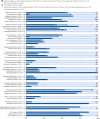Self-Reported Efficacy of Treatments in Cluster Headache: a Systematic Review of Survey Studies
- PMID: 35759175
- PMCID: PMC9436841
- DOI: 10.1007/s11916-022-01063-5
Self-Reported Efficacy of Treatments in Cluster Headache: a Systematic Review of Survey Studies
Abstract
Purpose of review: The use and efficacy of various substances in the treatment of CH have been studied in several retrospective surveys. The aim of the study is to systematically review published survey studies to evaluate the reported efficacies of both established and unconventional substances in abortive and prophylactic treatment of both episodic and chronic CH, specifically assessing the consistency of the results.
Recent findings: No systematic review have been conducted of these studies previously. A systematic literature search with a set of search terms was conducted on PubMed. Retrospective surveys that quantified the self-reported efficacy of two or more CH treatments, published in English during 2000-2020, were included. Several key characteristics and results of the studies were extracted. A total of 994 articles were identified of which 9 were found to be eligible based on the selection criteria. In total, 5419 respondents were included. Oxygen and subcutaneous triptan injections were most reported as effective abortive treatments, while psilocybin and lysergic acid diethylamide were most commonly reported as effective prophylactic treatments. The reported efficacy of most substances was consistent across different studies, and there were marked differences in the reported efficacies of different substances. The reported order of efficacy is generally in agreement with clinical studies. The findings suggest that retrospective surveys can be used to obtain supporting information on the effects of various substances used in the treatment of CH and to form hypotheses about novel treatment methods. The consistently reported efficacy of psilocybin and LSD in prophylactic treatment indicates need for clinical studies.
Keywords: Cluster; Comparison; Efficacy; Headache; Review; Survey.
© 2022. The Author(s).
Conflict of interest statement
EADS serves on the scientific advisory boards of Clusterbusters, Inc. and Ceruvia Lifesciences. She receives no personal remuneration for this service. She currently receives research support from Ceruvia Lifesciences. The other authors declare that they have no competing interests.
Figures




References
-
- May A, Leone M, Afra J, Linde M, Sándor PS, Evers S, et al. EFNS guidelines on the treatment of cluster headache and other trigeminal-autonomic cephalalgias. Eur J Neurol. 2006;13(10):1066–1077. - PubMed
Publication types
MeSH terms
Substances
Grants and funding
LinkOut - more resources
Full Text Sources
Research Materials

